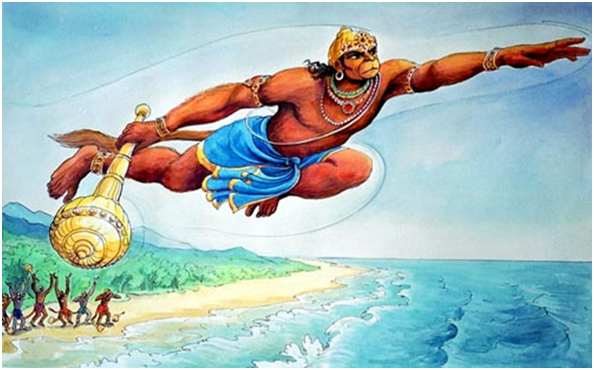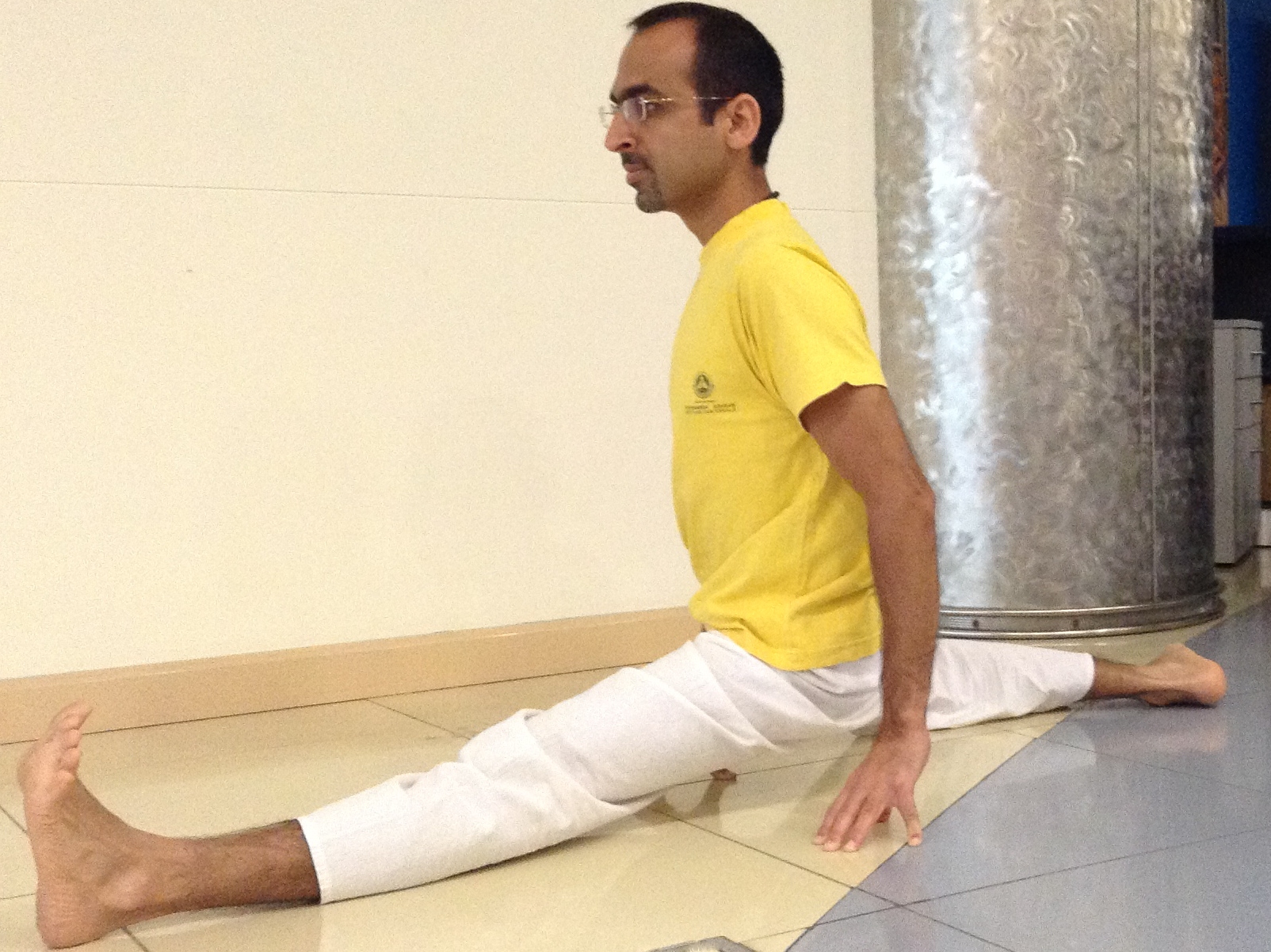Hanumanasana – the amalgamation of the myth with the practise
The Myth :
In the epic Ramayana, Hanuman is tasked with searching for Sita in Lanka. Hanumanasana symbolizes his giant leap from the southern shore of India to Lanka to achieve this goal.
In order to travel through the skies quickly, Hanuman who had the power to increase his size at will, assumed a body of immense proportions. So great was the momentum of his leap that he carried along with him trees in full blossom that got uprooted by the force. Covered with different blossoms, buds and sprouts Hanuman resembled a mountain himself. Soon the trees following Hanuman and the blossoms fell off into the sea making the ocean look even more beautiful.
Seeing Hanuman flying across the ocean, the King of the Ocean asked Mainaka the Mountain hidden under the seas to come up and provide relief to Hanuman by offering him a place to rest. But Hanuman had taken a vow not to rest until he reached Lanka and he politely declined Mainaka’s offer.
The devas [demi-Gods] were very impressed with Hanuman’s commitment but decided to test his determination for themselves. So they asked Surasa, the Mother of all Serpents to take a dreadful form of female Rakshasa and eat Hanuman up by obstructing his way.
Surasa tried to eat Hanuman by opening her mouth wide. But Hanuman immediately doubled his size. Surasa in turn increased her size matching his size and more. Then Hanuman in turn increased his size. Finally when Surasa increased her mouth size to accommodate a Hanuman of ninety yojanas, Hanuman swiftly shrunk himself to a size as small as a thumb and flew into her mouth and away. Surasa was very impressed with Hanuman’s intelligent handling of the situation and gave her blessings for his journey further.
As Hanuman continued he suddenly felt he was being dragged down. He was being attacked by the demon Simhika who had the power to hold one by his shadow. Hanuman first thought of trying to use his strength to fly away but soon realised that he would have to go back and reclaim his shadow. As he flew towards Simhika, she opened her mouth to grab him. Hanuman again reduced his size at the last minute and went inside Simhaka’s mouth and came back out by slashing her vital organs. He was then able to continue his journey without further incident and reach Lanka.
The Practise :
1.Start in Anjaneyasana with your right foot in front. Slowly straighten the right leg out in front of you.
2. Exhale and bending forward, press your fingertips to the floor.
3. Pick your left knee off the floor and take the left leg backwards. Just before you feel you have reached the limit of your stretch, stop straightening your left knee.
4. Inhale and breathe into the hamstrings in the right leg and soften the quadriceps in the left leg. Exhale and carefully drop the front of the left thigh, along with the back of the right thigh towards the ground. The centre of your right knee should point directly towards the ceiling.
5. Ensure that your back leg is extended straight out behind, from the hip, without being angled out to the side. The centre of that kneecap should press on to the floor.
6. Depending on your flexibility your thighs could now be in contact with the floor and you could either stretch your hands straight up (towards the ceiling) or bring them together in the Anjali Mudra (Salutation Seal)
7. Hold this pose for around a minute before releasing it. To do so, press your hands on to the floor and turn the front leg out slightly.
8. Repeat the pose on the other side
Incorporating the myth into the practise :
From Anjaneyasana as we straighten the leading leg and feel the first stretch to the hamstrings, it is tempting to just stay there and go no further since the rear leg is providing necessary stability and comfort – similar to how Hanuman’s journey was interrupted by Mainaka who offered him a place to rest and tempted him with fresh fruits and food. But just as Hanuman brushed away the offer and stayed on course the practitioner has to continue ahead despite the obvious discomfort.
As you lift the left knee of the floor you encounter your first ‘monster’….and you realise muscling your way through will only lead to injury. You need to start using your intuitive intelligence and like Hanuman shrunk himself you need to make micro-adjustments to go further and overcome this obstacle.
And finally to complete the journey, your thighs have to meet their shadows reflected below, just as Hanuman had to reclaim his shadow from Simhika. This last obstacle is the trickiest to overcome and requires patience and further micro-adjustments. Once the practitioner has mastered this last hurdle he/she can continue with relative ease and raise the hands off the floor to complete the ‘journey’.



![hanumanasana-splits-pose[1]](http://www.yogasmriti.com/wp-content/uploads/2013/05/hanumanasana-splits-pose1.jpg)
I enjoyed the class along with my family. Thanks for keeping the energy going
Thanks a lot for this interesting and useful information. It is very important to understand what asanas mean in order to practice yoga more efficiently.
Thanks for the detail, the breathing helps progress deeper into the pose. Love the stories embedded deep in mythology. Great work Mayank – you are an inspiration.
Thank you Mehboob, Yulia and Savio for your feedback. Yes its fascinating how much the myths can teach us!
I found this Asana very effective. It is a difficult one but served multiple muscles & great on the hamstring too. Great story! I however have the "chicken or egg" curiosity over the myth. Were the asanas built around these stories or vise versa 🙂
Hi Manoj,
A renowned yoga teacher commented – 'Modern Yoga has become just about the physical process, more specifically about stretching and even more specifically about 'stretching the hamstrings'! What an insightful comment!
And so while Hanumanasana is one of the most effective hamstring stretches it also one of the most easily 'linked to the myth' asana's (the correlation is direct and does not require much abstract or convoluted thinking) and it is only by understanding such history that we are able to go beyond the 'physical'. It is safe to assume that asanas were built around the stories (i.e. the stories came first); what is more difficult to distinguish is whether the asana was 'created' first and 'named' thereafter or whether the myth served as a muse for the asana.
In the end, it would be worthwhile to not over-think this lest we lose the 'lesson', rather better to remember what the famous Indologist Henrich Zimmer had to say, ‘The myths and symbols of India resist intellectualization and reduction to fixed significances. Such treatment would only sterilize them of their magic’!
Wish you many more magical moments on your yoga journey! Om shanti.
‘The myths and symbols of India resist intellectualization and reduction to fixed significances. Such treatment would only sterilize them of their magic’! ….so well said Mayank…Totally enjoying the yoga classes…look forward to learning many more mythological links to yoga
Being consistent for over two years at Mayank's class I am actually in bliss and harmony. I am surprised at my own ability to heal a severe knee dislocation and reducing my stress level. The Tue garden class is a blessing …..thanks Mayank for motivating us and prividing this great avenue…always look forward to it as combining breathing correctly with each posture makes so much sense now……
Thank you Rakhi and Chitra for your comments. The asanas when performed correctly and as per individual requirement have a therapeutic effect. And similarly the associated myths delve into the roots of human emotions and actions, teaching us valuable lessons along the way. Together, they help us discover the Healer and Teacher that are present [but often dormant] within us.
Hi Mayank ! I read your mail every week and the blog post with great interest and look forward to more enlightening posts 🙂 Just read about the new initiative you are supporting – lions in Kenya. Conservation of our natural resources (be it forests, wild life or even resources like paper/ electricity, etc.) is a cause close to my heart and I look forward to contributing in any way I can. Another issue which causes me great anguish is poaching – its rampant all over the world and especially so in India, as I learnt first hand during my recent visit to the Kanha Tiger Reserve.
I am thoroughly enjoying the read. Almost looking for the like button!! Love your classes because it appeals to the mind as much as it does to the body.